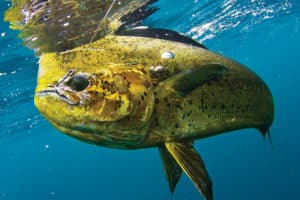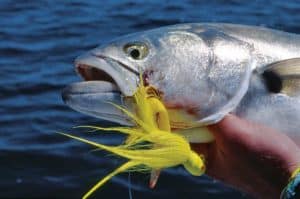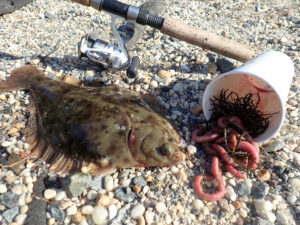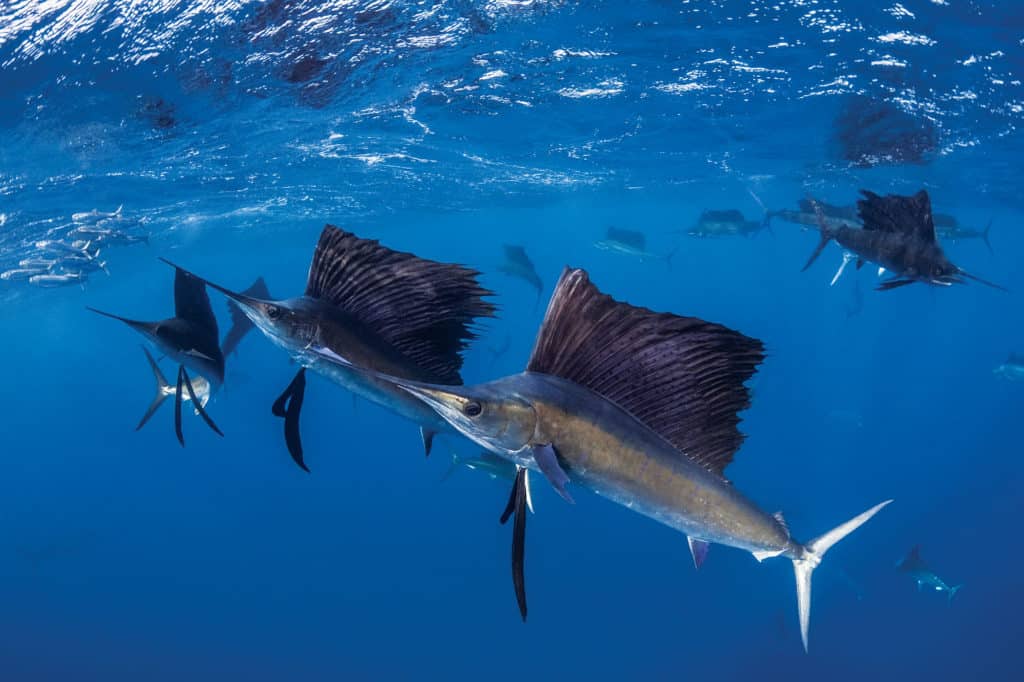
Cold fronts spun from mid-Atlantic winter snowstorms force sailfish south to warm, bait-filled waters off Florida’s coast. There, on cool, clear tournament days, anglers face jubilation and heartache rivaling the best football games on television. Like top NFL teams, competitive sailfishing requires unfaltering teamwork and skill when releases of feisty Atlantic sailfish come in triples and quads in less clock time than a Tom Brady game-winning scoring drive.
Comparing a winning sailfish team of 10 years ago with a competitive team today isn’t unlike the jump from good college football to the NFL — tournament sailfishing has changed that much — but not everyone wants to compete like a Tom Brady. Nor do they have to: Advancements in tournament-level play trickle down to more fish on everyday trips. Here’s how, from five sailfish-pro skippers who agreed to share their playbooks.
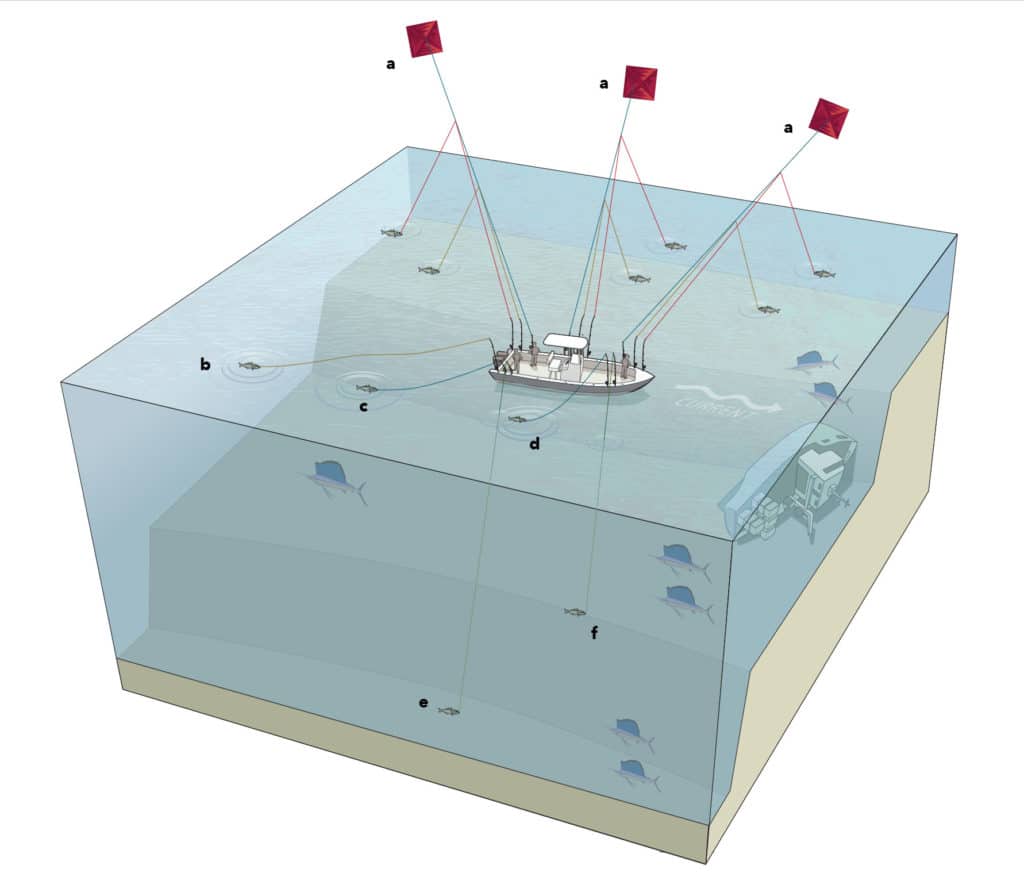
Game-Changing Innovation In the late ’80s, the Buffalo Bills’ no-huddle offense was novel and virtually unstoppable, and many teams utilize it today. Similarly, for anglers, “there are so many ways now for individuals and teams to learn the tricks we used to use to win tournaments,” Miami captain Ray Rosher (missbritt.com) says. From magazine articles, fishing seminars, crew turnover, and the World Wide Web, an innovation in technique or gear quickly finds its way through the fleet, negating any tourney edge. “It’s the entire package of equipment, knowledge and skill that makes a winning team nowadays,” Rosher adds.
“Ten years ago, you were fine pulling one single, six-arm dredge from a downrigger in the cockpit,” says Capt. Glenn Cameron (captaincameron.com), who trolls mostly for sailfish off Stuart, Florida. “Now you need triple or quad dredges with droppers just to stay at the top of the fleet.”
Equipment has evolved similarly. “I can flip a switch at the helm to clear a dredge, or I can throw a lever and retrieve it as slowly as I want, fishing it all the way to the boat,” Cameron says, allowing his crew to look for multiple hookups.
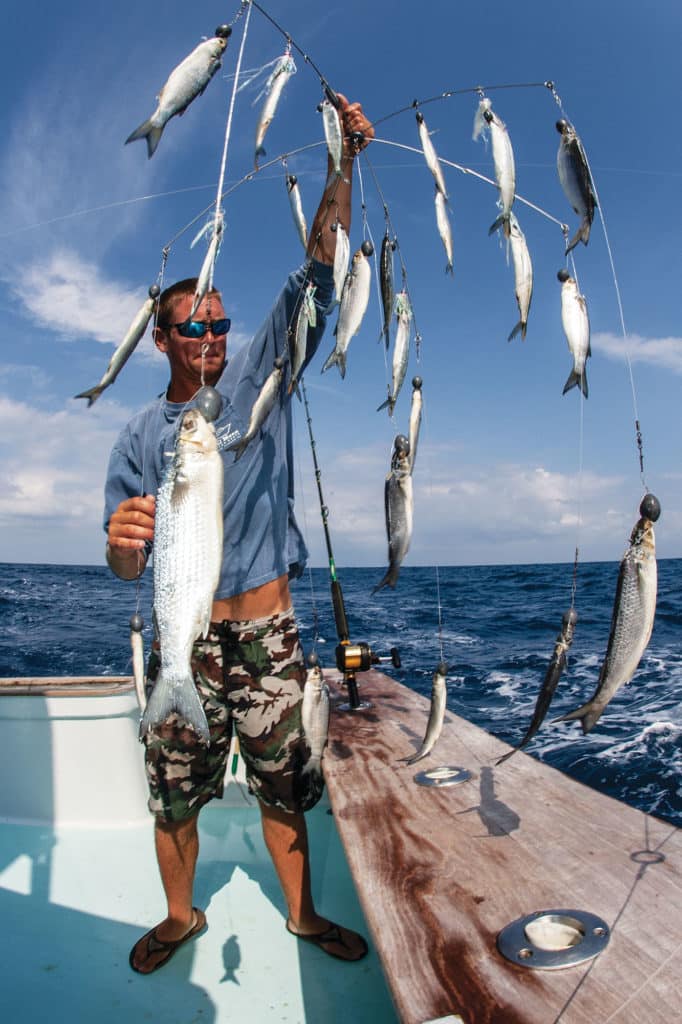
Points on the Board “To be competitive today, you need at least doubles if the fishing is slow, and triples and quads are common. We’ve always fished for multiples,” Cameron adds, “but now most of the fleet is proficient at it.”
When he’s not in a tournament, Cameron pulls more sails into his spread with one or two double-tiered dredges, each with 12 artificial mullet and 12 natural baits. “Continuing to fish after you’re hooked up increases your odds of multiples tenfold,” he adds.
“It’s so important to get a good, clean hookup on the first fish,” Rosher says. Constant attention keeps kite baits near the surface, where an aggressive sailfish won’t tangle in the leader, and a smooth drop-back aids proper hook placement. “That first bite gives everyone a warning that fish are around, but if you have to aggressively chase that first fish because it’s wrapped up, you hurt your chances for more bites.”
“Sometimes you’ll get three or four bites right away,” says Capt. Randy Yates (missanniecharters.com), out of West Palm Beach. “Usually, the fish are in looser groups, but sailfish attract sailfish. While you’re fighting one or two, you’ll get another bite, and another. That’s the way to catch multiples and win tournaments.
“You have to get kite baits back out right away to keep the ball in play,” Yates continues. “When you’re trolling, keep working that pod of fish. Either way, once you hook up, keep sending out baits until they all have fish on them.”
When not in a tournament, Yates says, “even with a short crew, we always fire out baits the best we can so we can hook more while they’re biting.”
Winning Percentages Whether it’s passes completed for first downs or hooked fish turned into releases, top teams maximize opportunities. “Every boat is going to see about the same number of fish,” says Florida Keys captain Marty Lewis (mainattraction.org). “If you hook 20 fish and catch 19, you’re probably going to win that tournament.”
This holds true for both kite-fishing and trolling. “With J hooks, if a fish comes up jumping, odds are 50-50 it will come off. Eighty percent used to be a really good overall hookup average,” Cameron says of J-hook days. “Now that we’ve got a decade of experience with circle hooks, you’ve got to be above a 90 percent catch rate to win.”
The trick is to remember to let fish come tight on their own. “Circle hooks are so much more forgiving, particularly for trolling,” Cameron says. “If a fish comes up jumping, you pretty much have it. Even if you have to work out a backlash, as long as you pay out the line smoothly, you’re in good shape.”
Read Next: Billfish Teaser Tactics of Tournament Experts
Early this past May, Lewis released 61 sails on a charter on one day, and 44 on another, all sight-casting to “tailing” sailfish — those surfing down big waves while feeding. “A third of the time there’s another fish there we don’t see,” Lewis says. “Position the boat upwind of a tailer so the angler can cast cleanly in front of the fish. Once it’s hooked, throw another bait anywhere within 20 feet. If there is another sailfish, it will find the bait.”
There’s a caveat though. “We catch them one at a time a lot faster than multiples, particularly in a tournament where we have to record video and retrieve the leader,” Lewis explains. “I’ll have another person in the tower watching for fish while I’m backing down — if we already know where the next fish is. I’m not going to wait around and hope I catch another.”
Play Calls Lewis’ high-percentage quick strikes pay off in the Keys, where tailing fish often stack tight to the reef. Farther north, Rosher allows big plays to develop. “I’ve seen as many as 15 more fish swimming with one tailer or free-jumper. Particularly in calm conditions and light current, they might not be moving fast,” he explains. “Have patience. I’ve seen guys give up and leave, and someone else comes in there and gets the bite. If you have many tailing fish and good sunlight, maybe pulling up your spread and sight-fishing is the right call,” Rosher says, particularly in a crowded fleet, “but if I have the room and the right conditions, I’ll pick up my kite baits and re-drop them ahead of those fish.”
To pick off a pod of fish while trolling, Yates says, “see if you can mark the fish, then save a waypoint and make a pass on just the right tack so your baits look perfect.”
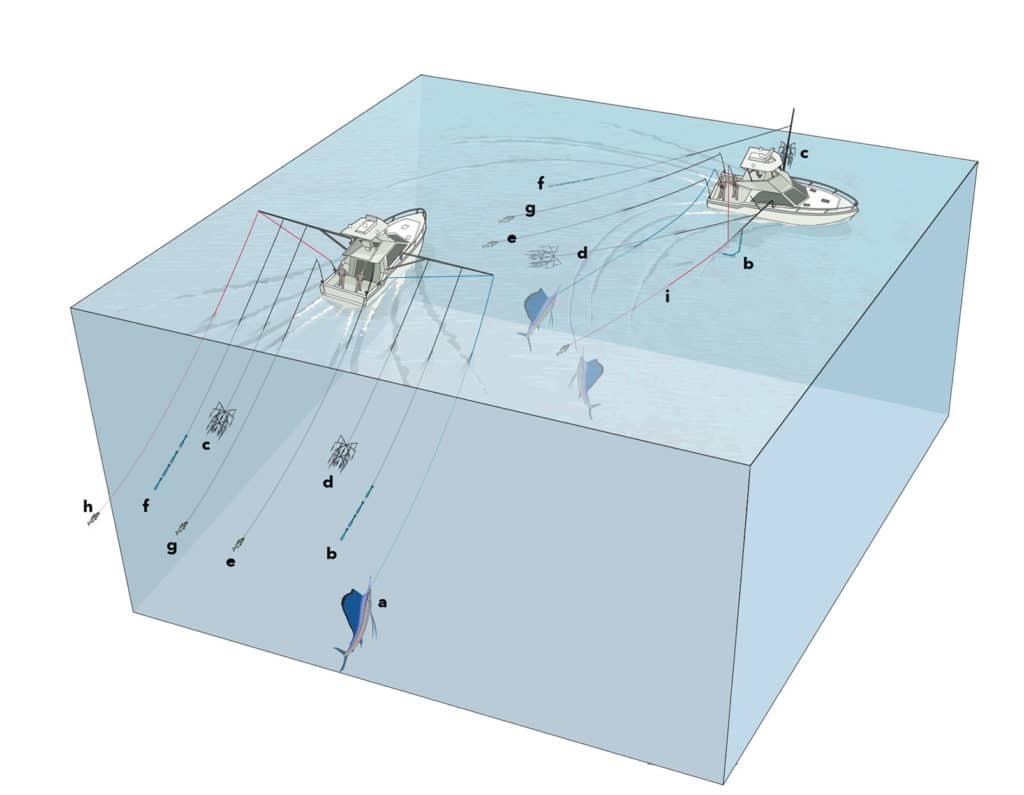
Game Plan Top NFL teams today might change their offense for just one opponent. Successful sailfish skippers can do the same. “South of Palm Beach Inlet, the depth range sailfish prefer is within a mile of the beach,” Yates says, which lends itself to kite-fishing. “Once you get north of the Loran tower, 5 miles north of Jupiter Inlet, it’s 3 or 4 miles from 80 feet deep out to 130 feet. If I know there is a good rip or edge, I might kite-fish, but trolling is certainly better for hunting where there is a lot of bottom to cover.”
Yates picks his plan, typically two days before a tournament, based largely on conditions. “If there’s not much current, we might cover 1 mile in an hour of kite-fishing. When I’m trolling at 6 or 7 mph, it’s a lot easier to find the fish,” he says, adding that “if the forecast is for zero wind, that’s the kiss of death for kite-fishing.”
Tournament rules also come into play. “If one sailfish is worth 300 points trolling or 200 points on live bait, it’s a no-brainer. I don’t think there is a clear advantage to live bait the way we’re trolling now, with 50 mullet on each dredge and constantly prospecting” — describing an angler continually winding up and then free-spooling a bait behind the dredge, which mimics a straggler falling behind the school.
Yates seldom moves if he’s catching at least occasional fish, with one exception. “If you’re picking up a few fish, but so is everyone else, and you know it won’t be enough to win, you might try a Hail Mary,” he says. “Get away from the fleet, and see if you can find a body of fish. You might catch 10 fish before everyone figures out where you are.”
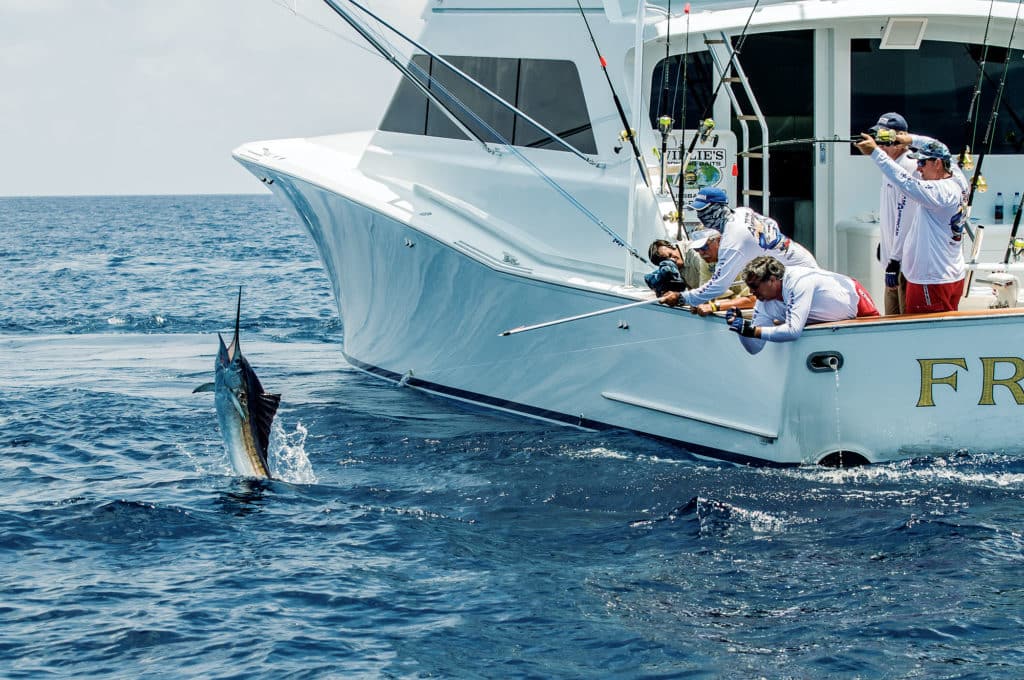
Coaching and Practice “If a fish comes up jumping before the reel is engaged, some anglers might wind, and others go into free-spool,” Rosher says. Either action can be correct, but everyone aboard has to agree on one action before fish are in play so all teammates know what to do next.
“What if multiple fish go in opposite directions?” Rosher asks. “Sea conditions and safety dictate whether someone goes to the bow on a cabin boat, but that has to be discussed beforehand so the captain knows what he has to do to get those fish.”
“I’m looking for the crew to anticipate every action with their own reaction,” Cameron adds. “If a fish shows up on a squid chain, I need them to know to pick up a pitch bait with a skirt because the fish is already keyed in to color. If I have to tell an angler to put down a rod with a naked ballyhoo, then I’ve lost a step.”
Bait Blitz If the perfect pressure and feel of a football is critical, then so is bait condition. “We’re catching our live bait at least one month in advance,” Lewis says. “We cage them up and feed them. When fish see a bait that is vibrant and active, they’re a lot more likely to chase it than if it’s weak, lethargic and has lost its color.
“I have five livewells in the boat, and I carry five flavors, based on the conditions of the day. If we see sailfish showering ballyhoo, we’ll use ballyhoo. When we’re kite-fishing on windy days, we’ll choose bigger baits that are easier for both sailfish and anglers to see, and they help keep lines tight in the wind. For tailers, pilchards are a perfect sailfish snack. They’re easy to cast and they stay on the hook well.”
Trolling teams prefer fresh ballyhoo baits, when available. “The mates are catching mullet for dredges the night before, fresh from the river,” Yates says. “And we’re using wedged mullet, because they make a thicker bait, instead of split tails.”
Game-Winning Tools “We’re using bait tubes, with six baits pre-bridled,” Rosher says. “That cuts our kite-deployment time in half, and eliminates the twisted leaders and tip wraps we’d get when we put baits in buckets on deck.
“We also switched to synthetic needles. With stainless needles, one sharp edge can nick and weaken rubber bands,” Rosher adds. Material memory — so rubber bands stretch and then return to their proper size — is also key. “If there is any separation, the hook can turn and bury itself into the bait, causing a missed hookup.”
“Today’s electronics are marking more fish, and it’s a lot easier for average people, who aren’t on the water every day, to use them well,” Cameron says. “We’re tuning our boats better too. Engines aligned, props computer-balanced, cutlass bearings that don’t squeal — it’s not that those things attract fish, it’s that not doing them drives away fish.”
“Guys have really figured out the big center-consoles for kite-fishing,” Yates says. “They’re fast and super mobile; they can be somewhere in the blink of an eye. When the fish are balling bait near the surface, the underwater profile of bigger boats, and the noise of the diesels and generator, drives down fish, but the center-consoles can get right in there. They also get on individual fish faster, plus it’s easy to fish off the bow and the stern.”
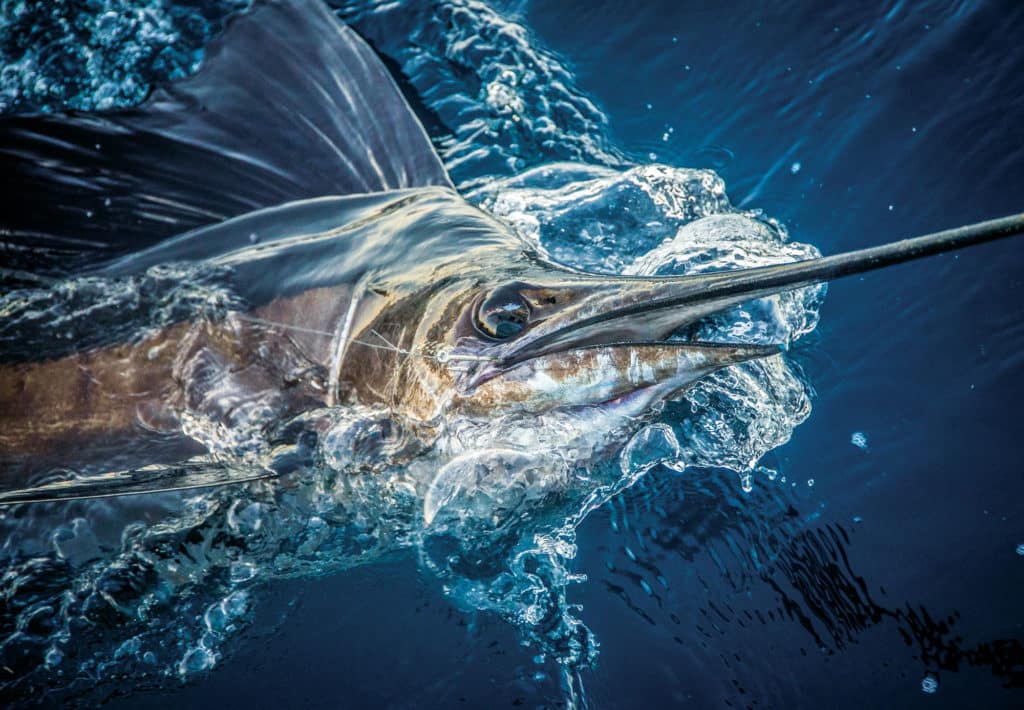
The Winning Edge Besides his record for Super Bowl wins, Tom Brady is on a very short list of quarterbacks who have lost three or more Super Bowls. (Others include John Elway, Fran Tarkenton, and Jim Kelly, who has four championship-game losses.) No doubt as with those quarterbacks, “it’s when you lose by one fish and you’re haunted by what you could have done differently that you learn the most,” Rosher says. “You have to think about what held you back from success, and understand what you can do as a team and as an individual the next time.”
What’s It Like to Win the Big Game? “One of my most memorable tournament wins took 19 years before we finally put it all together,” Rosher says. In five of those 19 years, his team had been just a few fish from winning. “We pulled hooks, missed bites. Those mistakes taught us a lot.” Finally, after 18 annual letdowns, Rosher landed in first place. “That’s when it hit me,” he says of the moment. “What makes success so sweet is the relief you feel after many years of trying.”
Most anglers aren’t chasing a perfect tournament finish, but the success of a perfect day fishing can be just as sweet.

